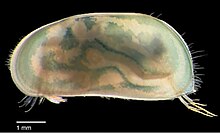| Cyprididae | |
|---|---|
 | |
| Chlamydotheca unispinosa | |
| Scientific classification | |
| Domain: | Eukaryota |
| Kingdom: | Animalia |
| Phylum: | Arthropoda |
| Class: | Ostracoda |
| Order: | Podocopida |
| Superfamily: | Cypridoidea |
| Family: | Cyprididae Baird, 1845 [1] |
| Subfamilies | |
| Synonyms | |
| |
Cyprididae is "the most diverse group of freshwater ostracods". [2] It contains over 1000 species, which represents 50% of the known species of freshwater ostracods (other speciose families include Candonidae, with 25%, and Limnocytheridae, with 10%). [3] Around 60% of genera in the family are endemic to a single zoogeographic region. [3] The family contains 16 subfamilies, and is most diverse in the Afrotropical realm, with over 300 species in 45 genera. [3] Many Cyprididae occur in temporary water bodies and have drought-resistant eggs, mixed/parthenogenetic reproduction and ability to swim. These biological attributes pre-adapt them to form successful radiations in these habitats. [4] Bennelongia is an interesting genus in the family Cyprididae. It may be the last true descendant of the Mesozoic (and now extinct) lineage of Cypridea , which was a dominant lineage of ostracod in non-marine waters in the Cretaceous. [3]